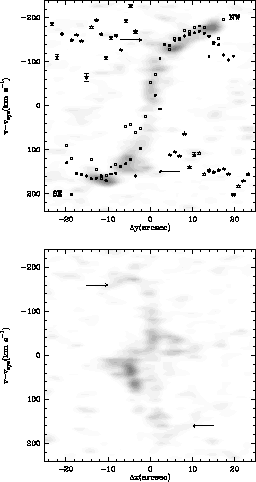![]() CO emission is concentrated in a compact nuclear disk of
average radius r
CO emission is concentrated in a compact nuclear disk of
average radius r ![]() 12
12 ![]() (1.2kpc). In the outer disk, from
r=20
(1.2kpc). In the outer disk, from
r=20 ![]() to r=100
to r=100 ![]() (2-10kpc),
(2-10kpc), ![]() CO is not detected
and the neutral gas content is largely dominated by HI. The observed
CO is not detected
and the neutral gas content is largely dominated by HI. The observed
![]() CO velocity field pattern corresponds to a gaseous disk with a
sense of rotation opposite to that of the stars.
Counter-rotation is shared by molecular and ionized gas in the
center. There is no strong evidence of
CO velocity field pattern corresponds to a gaseous disk with a
sense of rotation opposite to that of the stars.
Counter-rotation is shared by molecular and ionized gas in the
center. There is no strong evidence of ![]() CO emission from gas in
direct rotation. The estimated molecular mass in the
CO emission from gas in
direct rotation. The estimated molecular mass in the ![]() CO
nuclear disk is M(H
CO
nuclear disk is M(H ![]() )
) ![]() 0.3
0.3 ![]() 10
10 ![]() M
M ![]() , 3 times
lower than the mass of the HI disk.
, 3 times
lower than the mass of the HI disk.
Within the nuclear disk, ![]() CO is distributed in a central source
of
CO is distributed in a central source
of ![]() 1
1 ![]() (100pc) radius where the derived
(100pc) radius where the derived ![]() CO
rotation curve reaches
CO
rotation curve reaches ![]() 240kms
240kms ![]() , surrounded by a
pseudo-ring of average radius
, surrounded by a
pseudo-ring of average radius ![]() 6
6 ![]() (600pc) characterized
by strong non-circular motions. Dynamics of molecular gas,
characterized by a regular counter-rotating pattern, streaming motions
typical of a steady density-wave driven flow and normal
(600pc) characterized
by strong non-circular motions. Dynamics of molecular gas,
characterized by a regular counter-rotating pattern, streaming motions
typical of a steady density-wave driven flow and normal ![]() CO line
widths preclude the occurrence of violent large scale shocks or of a
non-equilibrium dynamical state for the gas.
CO line
widths preclude the occurrence of violent large scale shocks or of a
non-equilibrium dynamical state for the gas.
The available optical-(H ![]() , N[II] and S[II]) and
radio-continuum data (at 12.6cm and 21cm) indicate that no violent
burst of star formation is associated with the nuclear molecular
gas. This is confirmed by the lack of IRAS flux record for the nucleus
of NGC 3626. The present
, N[II] and S[II]) and
radio-continuum data (at 12.6cm and 21cm) indicate that no violent
burst of star formation is associated with the nuclear molecular
gas. This is confirmed by the lack of IRAS flux record for the nucleus
of NGC 3626. The present ![]() CO observations suggest that we are
probably seeing a late stage of a merger happened in NGC 3626.
CO observations suggest that we are
probably seeing a late stage of a merger happened in NGC 3626.

Figure: a(top) The ![]() CO(1-0) position-velocity plot (grey
scale) taken along the major axis of NGC 3626, showing
counter-rotation with respect to the stars. Stars kinematics is
derived from H
CO(1-0) position-velocity plot (grey
scale) taken along the major axis of NGC 3626, showing
counter-rotation with respect to the stars. Stars kinematics is
derived from H ![]() absorption lines (star like markers).
Superposed are the radial velocities of ionized gas observed using
several tracers: H
absorption lines (star like markers).
Superposed are the radial velocities of ionized gas observed using
several tracers: H ![]() (filled circles) and N[II](open
squares). The anomalous
(filled circles) and N[II](open
squares). The anomalous ![]() CO component (see text) is
indicated by the arrows. b(bottom) The
CO component (see text) is
indicated by the arrows. b(bottom) The ![]() CO(1-0)
position-velocity diagram along the minor axis of NGC 3626. Emission
at anomalous velocities is indicated by the arrows.
CO(1-0)
position-velocity diagram along the minor axis of NGC 3626. Emission
at anomalous velocities is indicated by the arrows.